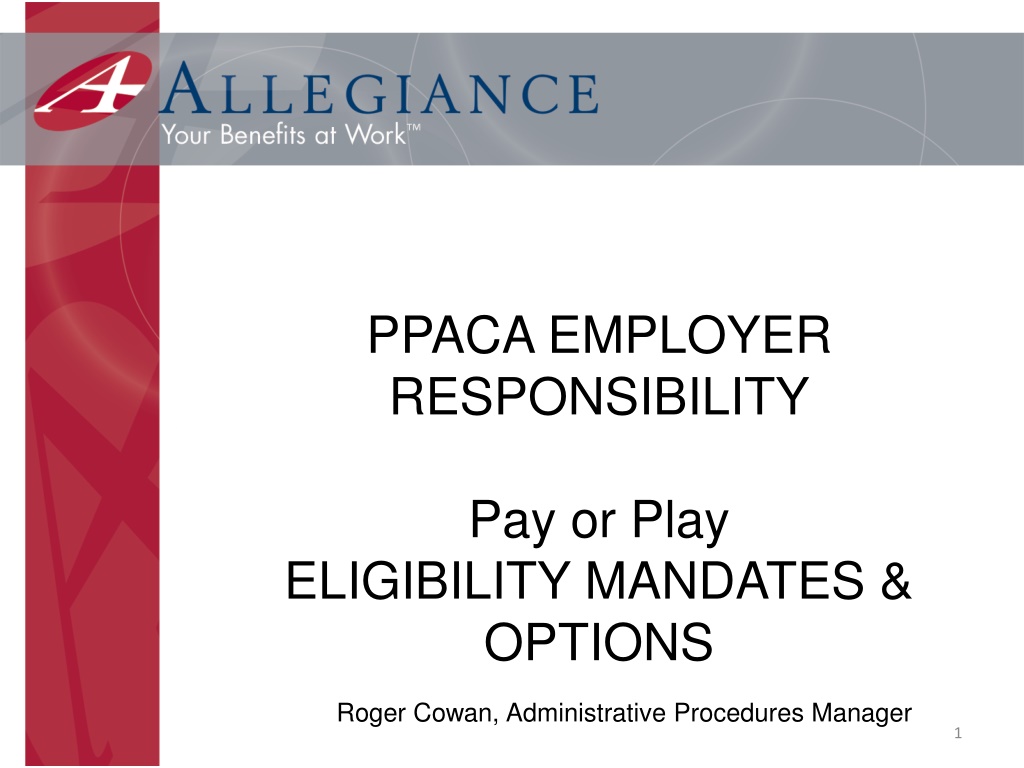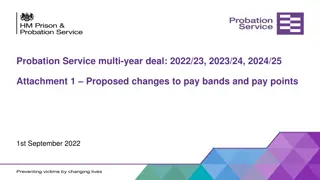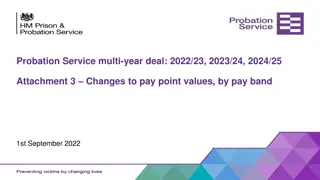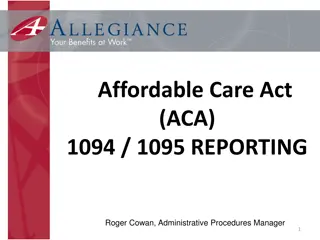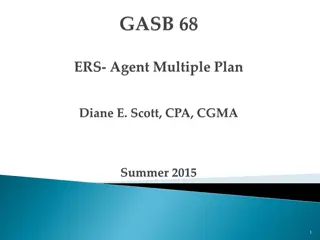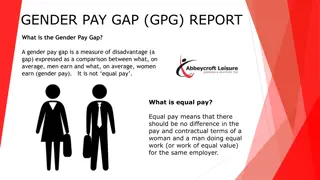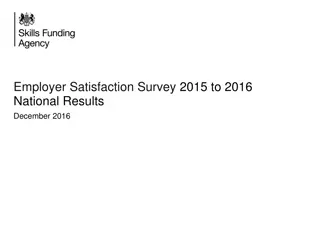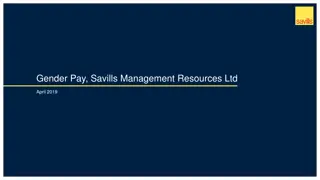PPACA Employer Responsibility: Pay or Play Eligibility Mandates & Options
This document outlines the PPACA employer responsibility concerning pay or play eligibility mandates and options. It covers exemptions, terms, employee count thresholds, computation methods, and specifics regarding applicable large employers. The content provides clarity on who is affected by these regulations and how they should be interpreted.
Download Presentation

Please find below an Image/Link to download the presentation.
The content on the website is provided AS IS for your information and personal use only. It may not be sold, licensed, or shared on other websites without obtaining consent from the author. Download presentation by click this link. If you encounter any issues during the download, it is possible that the publisher has removed the file from their server.
E N D
Presentation Transcript
PPACA EMPLOYER RESPONSIBILITY Pay or Play ELIGIBILITY MANDATES & OPTIONS Roger Cowan, Administrative Procedures Manager 1
DOES NOT APPLY TO: a. Flex plans and integrated HRA b. Excepted benefits (stand-alone dental and vision) c. Small groups ; currently less than 50 Full-Time employees (100 for 2015 only) Page 2
TERMS a. b. c. d. e. Minimum Essential Coverage plan (MEC) Minimum Value plan (MV) Seasonal Worker Variable Hour Employee Subsidy Eligible Member (SEM) Page 3
Applies starting with first Plan year on or after: January 1, 2015 for employers with 100 or more Full Time employees, and First Plan Year on or after January 1, 2016 for employers with 50 to 99 Full Time employees. Does not apply to employers with less than 50 Full Time employees. Employee count based upon majority of workdays in the prior calendar year. Several options to calculate Page 4
APPLICABLE LARGE EMPLOYER Is any plan with100 or more Full Time employees (2015)/50 or more Fulltime employees (2016): a. Includes all Full-Time Employees b. Includes Full-Time Equivalents (FTE) c. Excludes Seasonal Worker A seasonal worker is an employee who works less than 120* days per calendar year and whose employment is tied to a specific seasonal event. *For 2015 the time period is expanded to 6 months in a calendar year.
APPLICABLE LARGE EMPLOYER COMPUTATION a. Full-Time employee = 30 hours per week or, in the alternative, 130 hours per month b. Full-Time Equivalent (FTE) = hours of all employees who are not Full-Time employees added together and divided to equal 30 hours per week or 120 hours per month Page 6
Employees include only common-law employees as defined by Section 414 of the Internal Revenue Code. Independent contractors, owners, partners, shareholders, unpaid volunteers/interns of governmental employers and not-for-profits are not employees for this count even if covered. Page 7
For 2015 calculation, subtract seasonal workers that worked less than 6 months in 2014 calendar year regardless of hours. Page 8
Must also include all hours of paid leave or time off and FMLA, teacher on summer vacation and jury duty even if unpaid, but not any other unpaid leave. If based on all calculations and requirements above the total is 50 or more (100 or more for 2015) = Applicable Large Employer. Page 9
Classes of employees: Hourly: Must use actual hours including paid time off Salaried and commissioned: Employer must create a reasonable counting method that is applicable to all, taking into account normal hours worked, paid leave, and FLSA rules. The methodology picked by the employer must be consistently applied to all. Regulations indicate actual time worked or imputing a reasonable amount per day or week. Also includes FMLA and jury duty whether paid or not Page 10
PENALTIES APPLICABLE ONLY TO LARGE EMPLOYERS Two separate penalties: a. Penalty A: For sponsor failing to sponsor any health plan or failing to offer an MEC plan to substantially all Full-Time employees. Substantially all employees is specifically defined as at least 70% of full time employees in 2015 and at least 95% in subsequent years. b. Penalty B: For sponsoring a health plan that is not MV or that is unaffordable . Page 11
Penalty A: No health plan at all or fails to offer a MEC plan to substantially all Full-Time employees Penalty = $2,000 per year per Full-Time employee (does not include FTE) Pro-rated by month - monthly penalty is $166.67 Not tax deductible Does not count first 80 Full-Time employees in 2015 or first 30 full time employees in subsequent years in fine computation Ex for 2016: Employer A has 60 FT employees and does not sponsor a health plan. 60 30 = 30 Full-Time employees subject to penalty x $2,000 per year Page 12
Penalty A: *Safe Harbor: a MEC plan is deemed to have been offered to all Full-Time employees and their dependent children if the employer can show on a monthly basis that the coverage was offered to at least 70% of all Full-Time employees (69.9% will invoke the penalty..no rounding) in 2015. (Changes to 95% starting 2016.) Page 13
Penalty B: Plan does not meet MV or is unaffordable Penalty = $3,000 per year per employee for any SEM who applies for coverage and receives coverage and a subsidy on an Exchange Not tax deductible Pro-rated by month-monthly penalty is $250 Page 14
Fine imposed per Full-Time employee if either: a. Plan is not MV employee obtains Exchange coverage and a subsidy, or b. Cost to employee for single coverage exceeds 9.5% of household income* (unaffordable), and employee who is an SEM obtains coverage and a subsidy on Exchange * Safe harbor is to use employee s W-2 income. Page 15
After January 1, 2015: Full-Time employee redefined for health benefit plan purposes (2016 for employers with 50 to 99 FT employees) Nationwide, a Full-Time employee is any common- law employee who works 30 or more hours per week / 130 or more hours per month All Plans that have a higher hourly requirement will need to amend to avoid penalties. Critical to application of Penalty A for failing to offer coverage to all Full-Time employees and for Penalty B Page 16
Hours can be measured monthly as currently done or through new safe harbor, or a combination of both in some cases. Monthly measurement is retrospective for prior month. May result in missing some who work enough hours and creates risk of fine. Should define risk for each employer s workforce. May be able to amend plan requirements to avoid this risk Safe harbor or Look Back method will be discussed in detail in subsequent slides. May be able to use both methods based on certain employee classifications, e.g. salaried /hourly Page 17
Generally creates 3 employee classes: Full-Time: Those regularly scheduled and who work 30 hours or more per week / 130 per month. Includes paid leave, FMLA and jury duty. Part-Time: Those regularly scheduled to work less than 30 hour per week or who work less than 25 hours per week. Includes paid leave FMLA and jury duty. Variable Hourly: Those whose hours vary but sometimes work more than 30 hours per week. Includes paid leave, FMLA and Jury duty. Page 18
MORE NEW TERMS (Look Back Method) Administrative Period: Same as waiting period. Cannot exceed 90 days starting in 2014., even less in some cases Initial/Standard Measurement Period: Specific period of time to measure average hours to determine 30 hours per week / 130 per month for Full Time and Variable Hour. Not less than 3 months or more than 12 months. Substantiation Period: Period of time not less than 6 months but not more than 12 months that Full Time and Variable Hour Employees must be provided coverage if they average enough hours to be eligible during Standard Measurement Period. Page 19
Full-Time and Variable Hour Employees (contd): Coverage must be provided for entire Substantiation Period as long as employee is employed even if not working 30/130 or more hours If still averaging 30/130 at end of Substantiation Period may be reclassified as Full-Time and tracked based on monthly measurement period. May still use Measurement (look back) to determine continuing eligibility
Example of Look Back option. Employer A establishes a look back period of 6 months and uses the 130 hour per month option. Employer A hires Joe Employee on January 20th. The look back period then starts February 1 for Joe employee. If Joe employee is employed for the next 6 months then Joe s hours for that period must be totaled, and if Joe worked 780 hours or more during that period, he is eligible for coverage for a period of at least 6 months. (During the look back period, the employer is not subject to either of the fines above based on Joe s status, nor is Joe subject to the individual fine for not having coverage). Employer A has decided to use an Administrative Period of 30 days to figure out whether Joe is eligible. So, in this example, the look back period ends on July 31. The Administrative Period is 30 days, so Joe must be offered coverage effective September 1 for at least the next 6 months as long as Joe remains employed, regardless of the number of hours he works. However, on August 1 at the end of the first look back period, if Joe continues to be employed, a new look back period starts for the next 6 months and so on for as long as Joe is employed unless Joe is reclassified to a monthly measurement period position Page 21
Transitional rule for Standard Measurement Period Starts to apply on first Plan year on or after January 1, 2015 for 100 or more full time employees and first Plan year on or after 2016 for 50 to 99 Full time employees. First standard measurement period for Full-Time and Variable Hour employees does not have to be longer than 6 months backwards from first day of Plan year, even if it will be longer going forward.
Breaks in Service during look back: Classified as New employee again if break exceeds 26 weeks If less than 26 weeks and look back period is 12 months, must count all paid leave and FMLA and jury duty even if unpaid as work hours Rule of Parity for less than 26 weeks for unpaid leave there are two options: 1. Impute normal work hours to period of absence 2. Average over actual months worked
Educational Organizations: Rules are fact specific to organization, complex and currently incomplete, but generally require employers to count time off during breaks and summer vacation as time worked, but limit the amount of hours that must be imputed to no more than 501 hours
